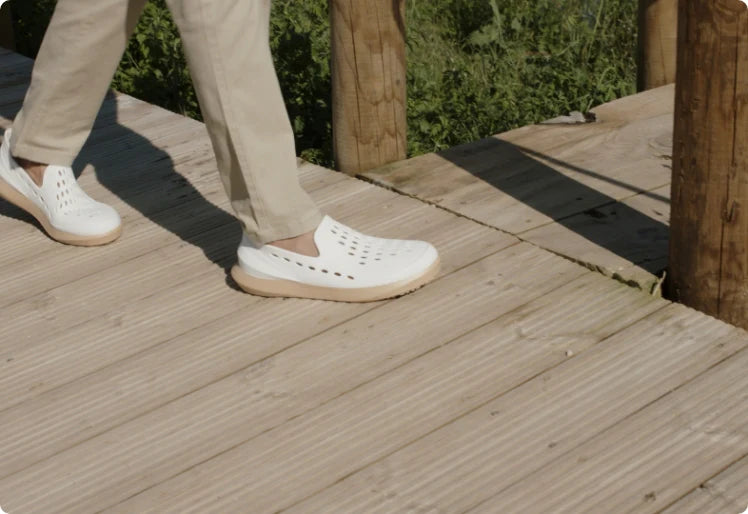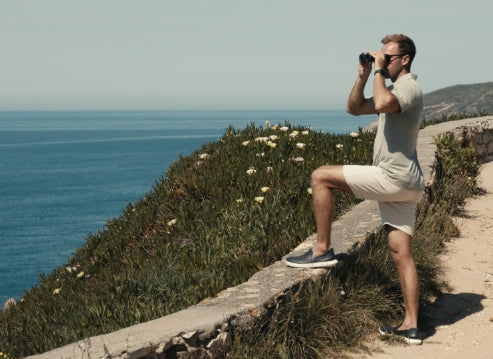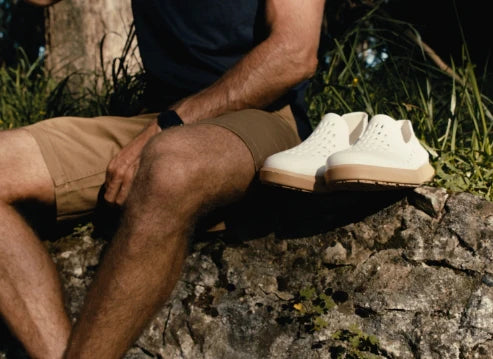Water shoes are specialized footwear designed to bridge the gap between land and water activities. These versatile shoes protect your feet while allowing you to move seamlessly between different environments.
Choosing the right water shoes can make or break your aquatic adventures. Picture yourself walking on hot beach sand, navigating slippery rocks, or exploring underwater reefs - your feet need proper protection and support for each scenario.
Key aspects of water shoes include:
- Quick-drying materials that prevent waterlogging
- Protective soles that guard against sharp objects
- Enhanced grip for slippery surfaces
- Comfortable fit for extended wear
Whether you're planning a beach vacation, engaging in water sports, or simply need reliable footwear for wet conditions, understanding water shoes is essential. This guide will walk you through:
- Different types and materials used in water shoes
- Benefits of wearing proper aquatic footwear
- Activities where water shoes excel
- Maintenance tips for long-lasting performance
- How to select the perfect pair for your needs
Your choice of water shoes can significantly impact your comfort and safety during water-related activities. It's worth considering whether you prefer slip-on shoes or lace-up styles, as each has its own advantages that cater to different needs and preferences.
Understanding Water Shoes
Water shoes are a specific type of footwear designed for both land and water activities. Unlike regular shoes, these specialized shoes offer the protection of traditional footwear while also incorporating features specifically designed for aquatic environments.
Construction Materials
Water shoes are made from a combination of materials that enhance their performance in wet conditions:
Mesh Upper: Quick-drying synthetic mesh allows water to flow through while maintaining breathability
Neoprene: The same material used in wetsuits provides insulation and flexibility
Rubber Soles: Specialized non-slip compounds offer grip on wet surfaces
Drainage Ports: Strategic holes in the sole facilitate water evacuation
Key Design Features
In addition to the construction materials, water shoes also have several key design features that contribute to their functionality:
- Reinforced toe caps protect against underwater obstacles
- Elastic collar prevents sand and debris from entering
- Bungee lacing systems allow quick adjustments
- Lightweight construction reduces water drag
- Anti-microbial treatments combat odor-causing bacteria
Distinguishing Characteristics
Water shoes have several unique characteristics that set them apart from regular footwear:
- Water Management: Unlike regular shoes that trap moisture, water shoes actively channel water away from your feet
- Weight Distribution: The sole design spreads pressure evenly across rough underwater surfaces
- Grip Patterns: Specialized tread patterns maximize traction on slippery rocks and boat decks
- Material Selection: All components are chosen for their performance in wet conditions
- Anatomical Fit: The shoe structure accounts for foot expansion in water
The combination of these materials and features creates footwear that performs effectively in both wet and dry conditions. Water shoes prioritize quick-drying capabilities, protection, and grip while maintaining comfort during transitions between environments. These design choices reflect the specific demands of water-based activities, setting them apart from conventional athletic or casual footwear.
However, it's important to note that some individuals may require best shoes for 12-hour shifts if their lifestyle involves prolonged periods of standing or walking. Such footwear not only ensures comfort and support but also significantly impacts overall health and job performance.
Benefits of Wearing Water Shoes
Water shoes offer essential protection for your feet during aquatic activities. Here's what makes them invaluable:
- Superior Foot Protection
- Shield your feet from sharp rocks, broken shells, and coral reefs
- Prevent cuts and scrapes from underwater hazards
- Guard against hot sand burns and cold water discomfort
- Protect against unseen objects in murky waters
- Enhanced Grip and Stability
- Specialized rubber soles provide traction on wet surfaces
- Reduce slip risks on boat decks and poolside areas
- Maintain balance on slick rocks and river beds
- Outperform bare feet and flip-flops in wet conditions
- Temperature Management and Comfort
- Create a barrier between feet and extreme temperatures
- Keep feet warm in cold water conditions
- Prevent burning sensations from hot sand and surfaces
- Maintain comfort during transitions between water and land
- Additional Protection Features
- Minimize risk of blisters from prolonged water exposure
- Reduce chafing common with wet feet
- Prevent sand from collecting between toes
- Protect against small marine life and debris
The quick-drying properties of water shoes mean you can wear them continuously throughout your water activities without the discomfort of waterlogged footwear. Their lightweight design allows natural movement while maintaining the protection your feet need in aquatic environments.
Versatile Uses for Water Shoes
Water shoes shine in a variety of scenarios, adapting to different environments and activities. Here's where you can put your water shoes to work:
Water Sports
- Kayaking and paddling activities
- Snorkeling and diving expeditions
- Stand-up paddleboarding
- Surfing and bodyboarding
Beach Activities
- Beach volleyball and sports
- Shell collecting and tide pooling
- Rocky beach exploration
- Waterfall hikes
Outdoor Adventures
- River crossing during hikes
- Canyoning and gorge walking
- White water rafting
- Stream fishing and wade fishing
Recreational Activities
- Water parks and splash pads
- Pool activities and swimming lessons
- Boat deck activities
- Lake and riverside camping
Your water shoes can handle transitions between wet and dry environments with ease. They work well for activities that require quick movements in and out of water, such as hopping from rock to rock while exploring tide pools or moving between boat and shore during fishing trips.
These versatile shoes protect your feet during both planned water activities and unexpected encounters with wet conditions. The quick-drying properties make them ideal for day-long adventures where you might face multiple water crossings or varying terrain types.
Activities Best Suited for Water Shoes
Water shoes are perfect for certain water activities where their design features offer the most advantage. Here's a detailed look at activities where water shoes are absolutely necessary:
Beach Activities
- Walking on hot sand and pebbles
- Exploring tide pools
- Beach volleyball
- Shell collecting
Water Sports
- Paddleboarding: The grippy soles help maintain balance on slippery boards
- Tubing: Protection during water entry and exit
- White water rafting: Essential foot protection against rocks
- Surfing: Added grip when walking on wet surfaces
Adventure Activities
- Canyoning through water-filled gorges
- Wild swimming in natural water bodies
- Coasteering along rocky shorelines
- Waterfall hiking
Pool-Based Activities
- Water aerobics classes
- Pool walking and jogging
- Swimming lessons
- Aqua fitness routines
The quick-drying properties and protective features of water shoes make them ideal for these activities. Their specialized soles prevent slipping on wet surfaces, while the mesh uppers allow proper water drainage. The closed-toe design guards against stubbed toes and sharp objects, letting you focus on enjoying your chosen water activity.
Caring for Your Water Shoes
Proper maintenance extends the life of your water shoes and keeps them fresh for your next adventure. Here's how to care for your water shoes effectively:
Daily Care Routine
- Rinse thoroughly with fresh water after each use
- Remove insoles and dry separately
- Air dry in a well-ventilated area away from direct sunlight
- Store in a cool, dry place once completely dry
Deep Cleaning Steps
- Mix mild soap with warm water
- Use a soft brush to gently scrub the surfaces
- Pay special attention to mesh areas and drainage holes
- Clean the insoles separately with the same solution
- Rinse until water runs clear
Odor Prevention Tips
- Sprinkle baking soda inside shoes to absorb unwanted smells
- Use antibacterial shoe sprays designed for water footwear
- Never store wet shoes in sealed containers or bags
- Consider rotating between two pairs to allow complete drying
Storage Guidelines
- Keep shoes in mesh bags during off-season
- Avoid compressed or folded storage positions
- Check periodically for mold or mildew
- Store insoles separately to maintain shape
Salt water and sand can deteriorate water shoes quickly. A quick freshwater rinse removes these damaging elements and prevents material breakdown. Regular cleaning maintains the grip on your soles and preserves the shoe's protective features.
Conclusion - Choose the Right Pair of Water Shoes for Your Needs!
Selecting the perfect water shoes comes down to understanding your specific needs and activities. Consider these key factors when making your choice:
- Activity Type: Beach walking requires different features than kayaking or snorkeling
- Fit and Comfort: Your shoes should feel snug but not tight, with enough room for toe movement
- Sole Thickness: Thicker soles offer better protection for rocky surfaces, while thinner ones provide more flexibility
- Drainage Capability: Look for multiple drainage holes if you'll be frequently in and out of water
- Material Quality: Durable mesh and quick-drying materials extend the life of your shoes
The right water shoes serve as essential gear for your water adventures. They protect your feet, provide necessary grip, and enhance your comfort during water activities. Your choice directly impacts your safety and enjoyment - invest time in selecting a pair that matches your specific requirements and water activities.
Remember: A well-chosen pair of water shoes becomes your reliable companion for countless water adventures, making them a worthwhile investment for any water enthusiast.




